MGMT20144: Risks, Environmental Factors in Automotive Industry
VerifiedAdded on 2022/09/08
|9
|2152
|30
Report
AI Summary
This report delves into the risks and environmental factors impacting the automotive industry, focusing on companies like Cummins and Volvo. It explores the business structures of these firms, highlighting the influence of political, economic, social, technological, legal, and environmental factors on their decision-making processes. The report identifies key risks such as changing consumer preferences, legal regulations, and expansion challenges. It also suggests strategies for mitigating these risks, including establishing innovation and development teams, conducting thorough industry analysis, and performing competitor analysis. The conclusion emphasizes the importance of monitoring environmental factors and adapting to technological changes to ensure business success.
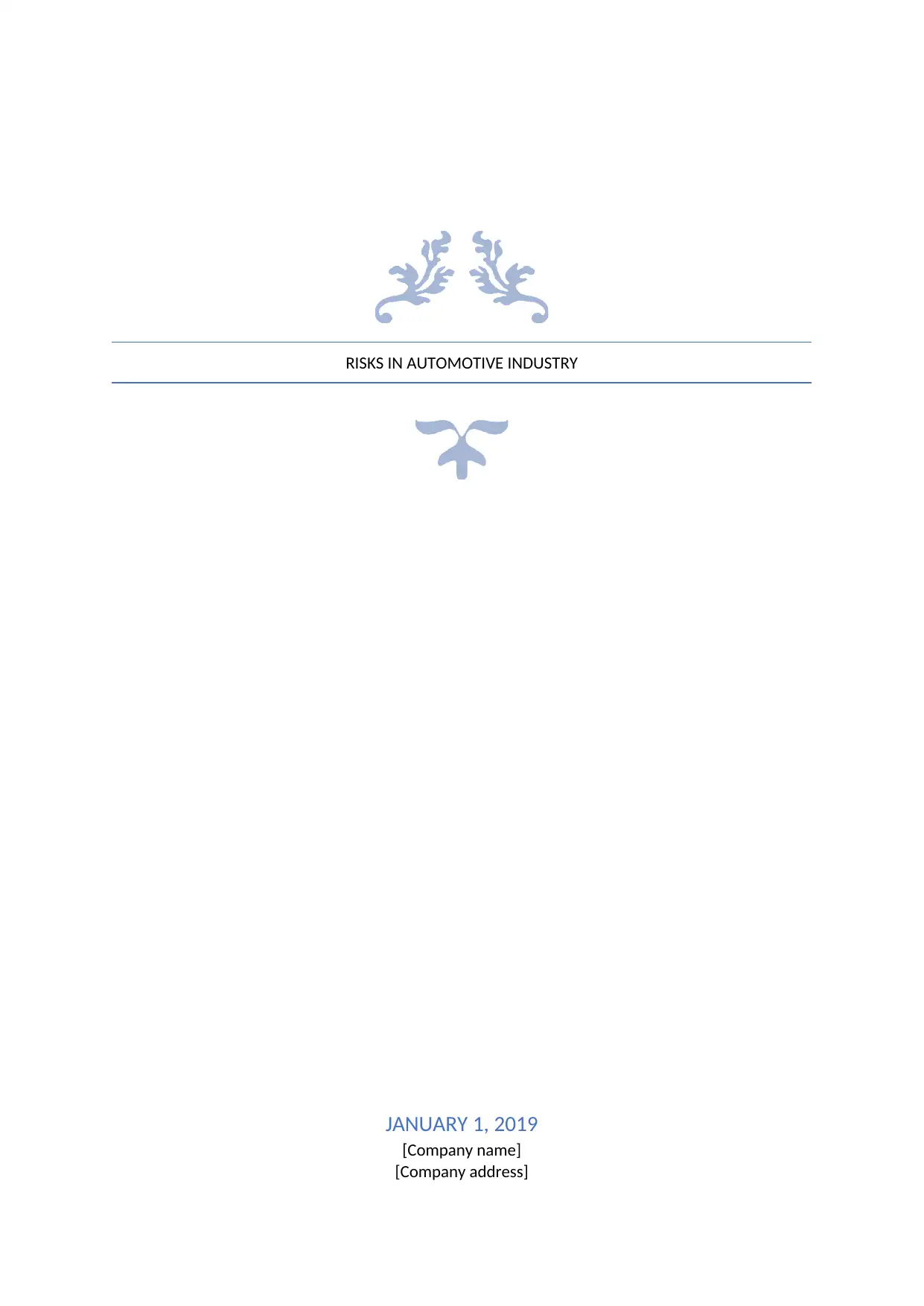
RISKS IN AUTOMOTIVE INDUSTRY
JANUARY 1, 2019
[Company name]
[Company address]
JANUARY 1, 2019
[Company name]
[Company address]
Paraphrase This Document
Need a fresh take? Get an instant paraphrase of this document with our AI Paraphraser
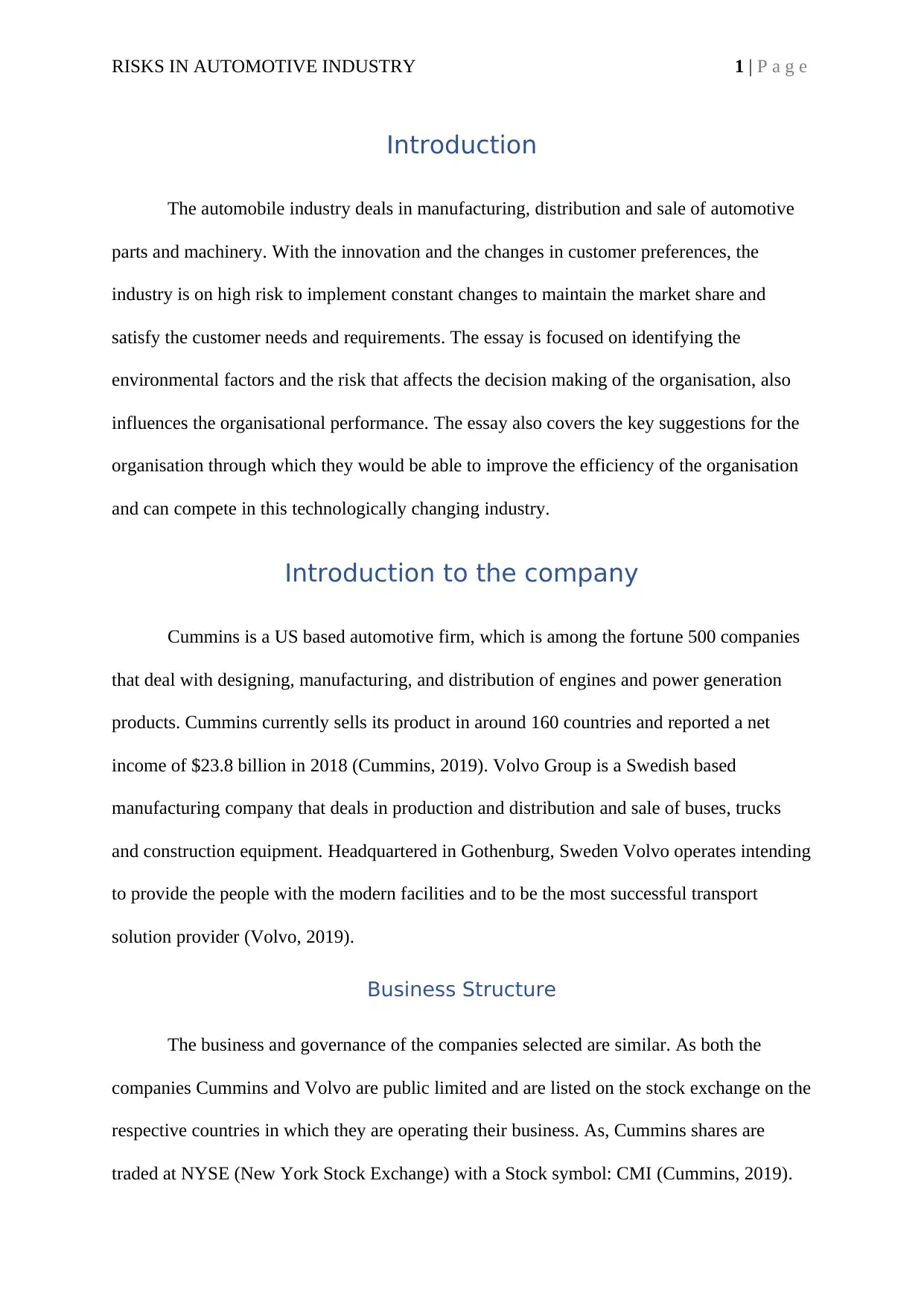
RISKS IN AUTOMOTIVE INDUSTRY 1 | P a g e
Introduction
The automobile industry deals in manufacturing, distribution and sale of automotive
parts and machinery. With the innovation and the changes in customer preferences, the
industry is on high risk to implement constant changes to maintain the market share and
satisfy the customer needs and requirements. The essay is focused on identifying the
environmental factors and the risk that affects the decision making of the organisation, also
influences the organisational performance. The essay also covers the key suggestions for the
organisation through which they would be able to improve the efficiency of the organisation
and can compete in this technologically changing industry.
Introduction to the company
Cummins is a US based automotive firm, which is among the fortune 500 companies
that deal with designing, manufacturing, and distribution of engines and power generation
products. Cummins currently sells its product in around 160 countries and reported a net
income of $23.8 billion in 2018 (Cummins, 2019). Volvo Group is a Swedish based
manufacturing company that deals in production and distribution and sale of buses, trucks
and construction equipment. Headquartered in Gothenburg, Sweden Volvo operates intending
to provide the people with the modern facilities and to be the most successful transport
solution provider (Volvo, 2019).
Business Structure
The business and governance of the companies selected are similar. As both the
companies Cummins and Volvo are public limited and are listed on the stock exchange on the
respective countries in which they are operating their business. As, Cummins shares are
traded at NYSE (New York Stock Exchange) with a Stock symbol: CMI (Cummins, 2019).
Introduction
The automobile industry deals in manufacturing, distribution and sale of automotive
parts and machinery. With the innovation and the changes in customer preferences, the
industry is on high risk to implement constant changes to maintain the market share and
satisfy the customer needs and requirements. The essay is focused on identifying the
environmental factors and the risk that affects the decision making of the organisation, also
influences the organisational performance. The essay also covers the key suggestions for the
organisation through which they would be able to improve the efficiency of the organisation
and can compete in this technologically changing industry.
Introduction to the company
Cummins is a US based automotive firm, which is among the fortune 500 companies
that deal with designing, manufacturing, and distribution of engines and power generation
products. Cummins currently sells its product in around 160 countries and reported a net
income of $23.8 billion in 2018 (Cummins, 2019). Volvo Group is a Swedish based
manufacturing company that deals in production and distribution and sale of buses, trucks
and construction equipment. Headquartered in Gothenburg, Sweden Volvo operates intending
to provide the people with the modern facilities and to be the most successful transport
solution provider (Volvo, 2019).
Business Structure
The business and governance of the companies selected are similar. As both the
companies Cummins and Volvo are public limited and are listed on the stock exchange on the
respective countries in which they are operating their business. As, Cummins shares are
traded at NYSE (New York Stock Exchange) with a Stock symbol: CMI (Cummins, 2019).
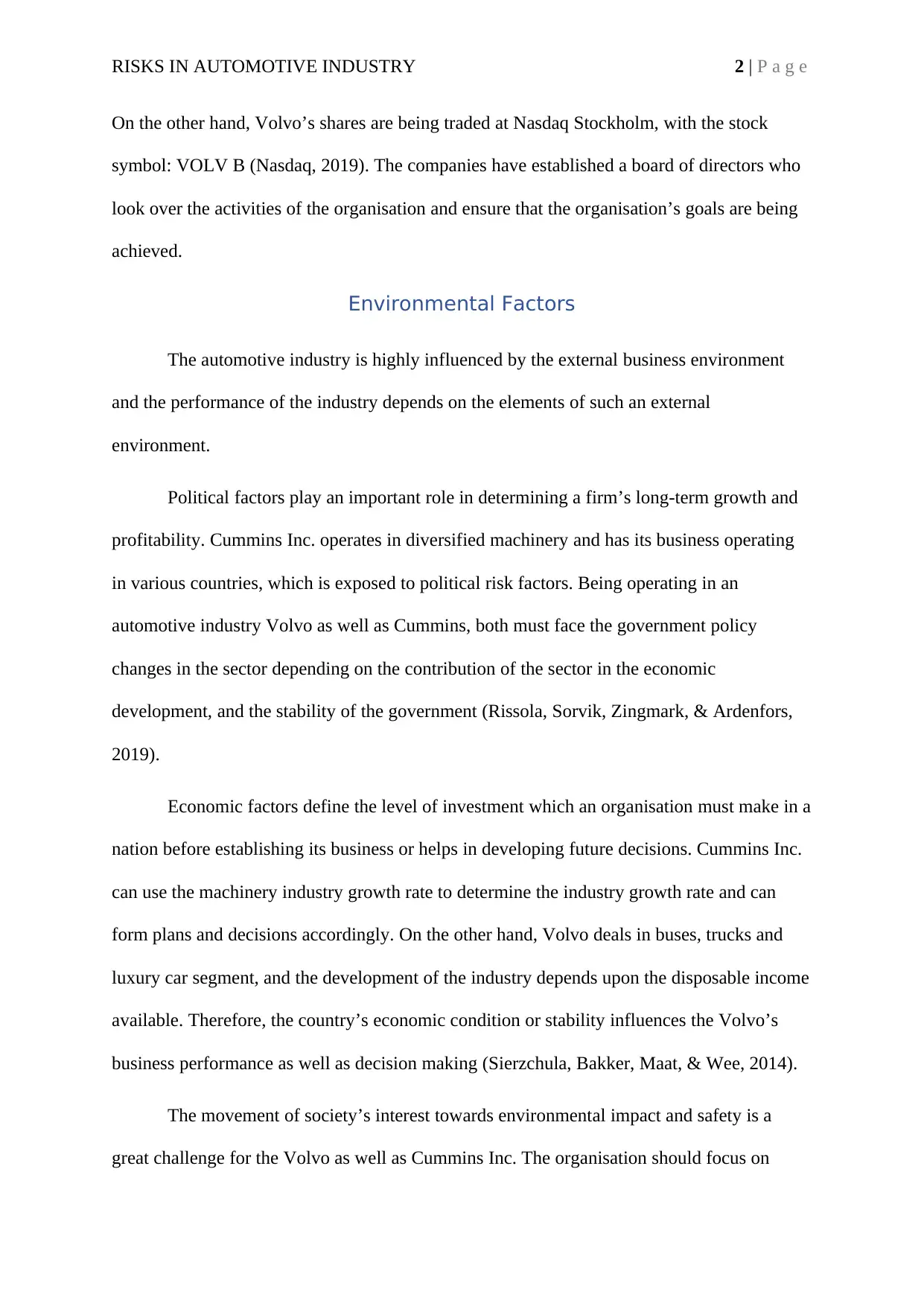
RISKS IN AUTOMOTIVE INDUSTRY 2 | P a g e
On the other hand, Volvo’s shares are being traded at Nasdaq Stockholm, with the stock
symbol: VOLV B (Nasdaq, 2019). The companies have established a board of directors who
look over the activities of the organisation and ensure that the organisation’s goals are being
achieved.
Environmental Factors
The automotive industry is highly influenced by the external business environment
and the performance of the industry depends on the elements of such an external
environment.
Political factors play an important role in determining a firm’s long-term growth and
profitability. Cummins Inc. operates in diversified machinery and has its business operating
in various countries, which is exposed to political risk factors. Being operating in an
automotive industry Volvo as well as Cummins, both must face the government policy
changes in the sector depending on the contribution of the sector in the economic
development, and the stability of the government (Rissola, Sorvik, Zingmark, & Ardenfors,
2019).
Economic factors define the level of investment which an organisation must make in a
nation before establishing its business or helps in developing future decisions. Cummins Inc.
can use the machinery industry growth rate to determine the industry growth rate and can
form plans and decisions accordingly. On the other hand, Volvo deals in buses, trucks and
luxury car segment, and the development of the industry depends upon the disposable income
available. Therefore, the country’s economic condition or stability influences the Volvo’s
business performance as well as decision making (Sierzchula, Bakker, Maat, & Wee, 2014).
The movement of society’s interest towards environmental impact and safety is a
great challenge for the Volvo as well as Cummins Inc. The organisation should focus on
On the other hand, Volvo’s shares are being traded at Nasdaq Stockholm, with the stock
symbol: VOLV B (Nasdaq, 2019). The companies have established a board of directors who
look over the activities of the organisation and ensure that the organisation’s goals are being
achieved.
Environmental Factors
The automotive industry is highly influenced by the external business environment
and the performance of the industry depends on the elements of such an external
environment.
Political factors play an important role in determining a firm’s long-term growth and
profitability. Cummins Inc. operates in diversified machinery and has its business operating
in various countries, which is exposed to political risk factors. Being operating in an
automotive industry Volvo as well as Cummins, both must face the government policy
changes in the sector depending on the contribution of the sector in the economic
development, and the stability of the government (Rissola, Sorvik, Zingmark, & Ardenfors,
2019).
Economic factors define the level of investment which an organisation must make in a
nation before establishing its business or helps in developing future decisions. Cummins Inc.
can use the machinery industry growth rate to determine the industry growth rate and can
form plans and decisions accordingly. On the other hand, Volvo deals in buses, trucks and
luxury car segment, and the development of the industry depends upon the disposable income
available. Therefore, the country’s economic condition or stability influences the Volvo’s
business performance as well as decision making (Sierzchula, Bakker, Maat, & Wee, 2014).
The movement of society’s interest towards environmental impact and safety is a
great challenge for the Volvo as well as Cummins Inc. The organisation should focus on
⊘ This is a preview!⊘
Do you want full access?
Subscribe today to unlock all pages.

Trusted by 1+ million students worldwide
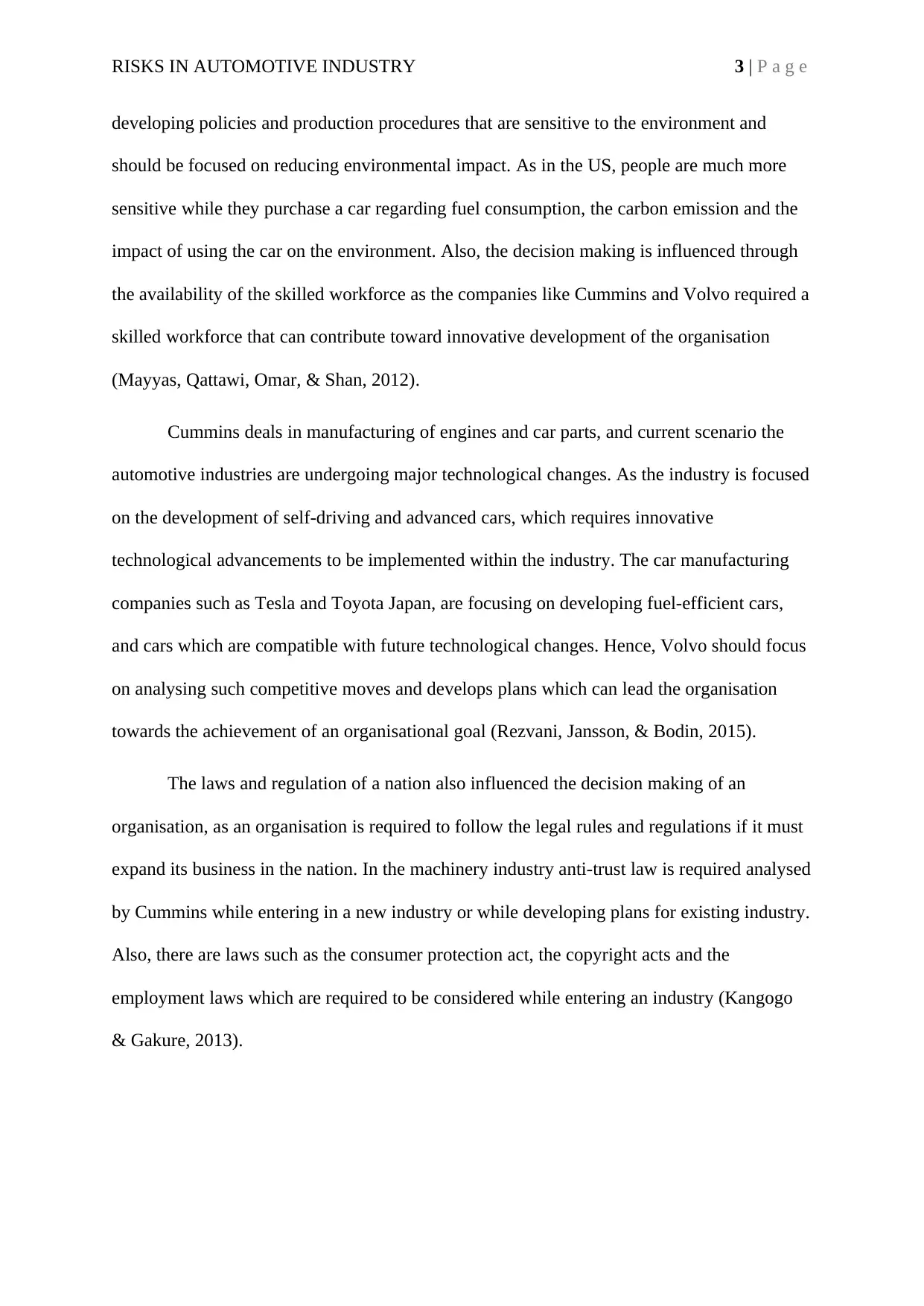
RISKS IN AUTOMOTIVE INDUSTRY 3 | P a g e
developing policies and production procedures that are sensitive to the environment and
should be focused on reducing environmental impact. As in the US, people are much more
sensitive while they purchase a car regarding fuel consumption, the carbon emission and the
impact of using the car on the environment. Also, the decision making is influenced through
the availability of the skilled workforce as the companies like Cummins and Volvo required a
skilled workforce that can contribute toward innovative development of the organisation
(Mayyas, Qattawi, Omar, & Shan, 2012).
Cummins deals in manufacturing of engines and car parts, and current scenario the
automotive industries are undergoing major technological changes. As the industry is focused
on the development of self-driving and advanced cars, which requires innovative
technological advancements to be implemented within the industry. The car manufacturing
companies such as Tesla and Toyota Japan, are focusing on developing fuel-efficient cars,
and cars which are compatible with future technological changes. Hence, Volvo should focus
on analysing such competitive moves and develops plans which can lead the organisation
towards the achievement of an organisational goal (Rezvani, Jansson, & Bodin, 2015).
The laws and regulation of a nation also influenced the decision making of an
organisation, as an organisation is required to follow the legal rules and regulations if it must
expand its business in the nation. In the machinery industry anti-trust law is required analysed
by Cummins while entering in a new industry or while developing plans for existing industry.
Also, there are laws such as the consumer protection act, the copyright acts and the
employment laws which are required to be considered while entering an industry (Kangogo
& Gakure, 2013).
developing policies and production procedures that are sensitive to the environment and
should be focused on reducing environmental impact. As in the US, people are much more
sensitive while they purchase a car regarding fuel consumption, the carbon emission and the
impact of using the car on the environment. Also, the decision making is influenced through
the availability of the skilled workforce as the companies like Cummins and Volvo required a
skilled workforce that can contribute toward innovative development of the organisation
(Mayyas, Qattawi, Omar, & Shan, 2012).
Cummins deals in manufacturing of engines and car parts, and current scenario the
automotive industries are undergoing major technological changes. As the industry is focused
on the development of self-driving and advanced cars, which requires innovative
technological advancements to be implemented within the industry. The car manufacturing
companies such as Tesla and Toyota Japan, are focusing on developing fuel-efficient cars,
and cars which are compatible with future technological changes. Hence, Volvo should focus
on analysing such competitive moves and develops plans which can lead the organisation
towards the achievement of an organisational goal (Rezvani, Jansson, & Bodin, 2015).
The laws and regulation of a nation also influenced the decision making of an
organisation, as an organisation is required to follow the legal rules and regulations if it must
expand its business in the nation. In the machinery industry anti-trust law is required analysed
by Cummins while entering in a new industry or while developing plans for existing industry.
Also, there are laws such as the consumer protection act, the copyright acts and the
employment laws which are required to be considered while entering an industry (Kangogo
& Gakure, 2013).
Paraphrase This Document
Need a fresh take? Get an instant paraphrase of this document with our AI Paraphraser

RISKS IN AUTOMOTIVE INDUSTRY 4 | P a g e
Risks faced by the organisation
The multinational organisations face various issues and risk, due to their complex
business structure and expanded business operations. Volvo faces the following risk while
operating its business and while making decisions:
Consumers preferences: The change in technology in the industry and the changes in
consumer preferences are the main risks that the car manufacturer Volvo faces. As with the
introduction of new technology within the industry the preferences of a consumer also get
shifted towards the new technology. Hence, while undertaking the decision-making process
Volvo must focus on the emerging technologies and the customer taste and preference in the
industry to beat the competition. As the consumers of the Cummins Inc. are the
manufacturers, and to maintain the market share, the organisation should focus on the
requirements of the manufacturer, and provide them with the respective innovative products
which can add value to the manufacturer’s final product (Jacobides, Macduffie, & Tae,
2015).
Legal rules and regulations: Volvo’s decision making also influenced the changing
legal rules and government policies. The change in government import-export policies and
the taxation rate influences the Volvo’s product prices and affect the operational and
performance results and the financial budgeting of the organisation. Cummins Inc. faces the
risk of legal rules and the regulations as it is the part of the automotive industry and any
change in legal rules will affect the Cummins decision making and policies, in the same
manner, it affects the Volvo (Guzik, 2013).
Expansion: As being a part of the globalised world an organisation can easily expand
its business operations, but it is not in case of every business. Volvo deals in the luxury car
segment and the innovative trucks and buses, which has a high market price as compared to
Risks faced by the organisation
The multinational organisations face various issues and risk, due to their complex
business structure and expanded business operations. Volvo faces the following risk while
operating its business and while making decisions:
Consumers preferences: The change in technology in the industry and the changes in
consumer preferences are the main risks that the car manufacturer Volvo faces. As with the
introduction of new technology within the industry the preferences of a consumer also get
shifted towards the new technology. Hence, while undertaking the decision-making process
Volvo must focus on the emerging technologies and the customer taste and preference in the
industry to beat the competition. As the consumers of the Cummins Inc. are the
manufacturers, and to maintain the market share, the organisation should focus on the
requirements of the manufacturer, and provide them with the respective innovative products
which can add value to the manufacturer’s final product (Jacobides, Macduffie, & Tae,
2015).
Legal rules and regulations: Volvo’s decision making also influenced the changing
legal rules and government policies. The change in government import-export policies and
the taxation rate influences the Volvo’s product prices and affect the operational and
performance results and the financial budgeting of the organisation. Cummins Inc. faces the
risk of legal rules and the regulations as it is the part of the automotive industry and any
change in legal rules will affect the Cummins decision making and policies, in the same
manner, it affects the Volvo (Guzik, 2013).
Expansion: As being a part of the globalised world an organisation can easily expand
its business operations, but it is not in case of every business. Volvo deals in the luxury car
segment and the innovative trucks and buses, which has a high market price as compared to
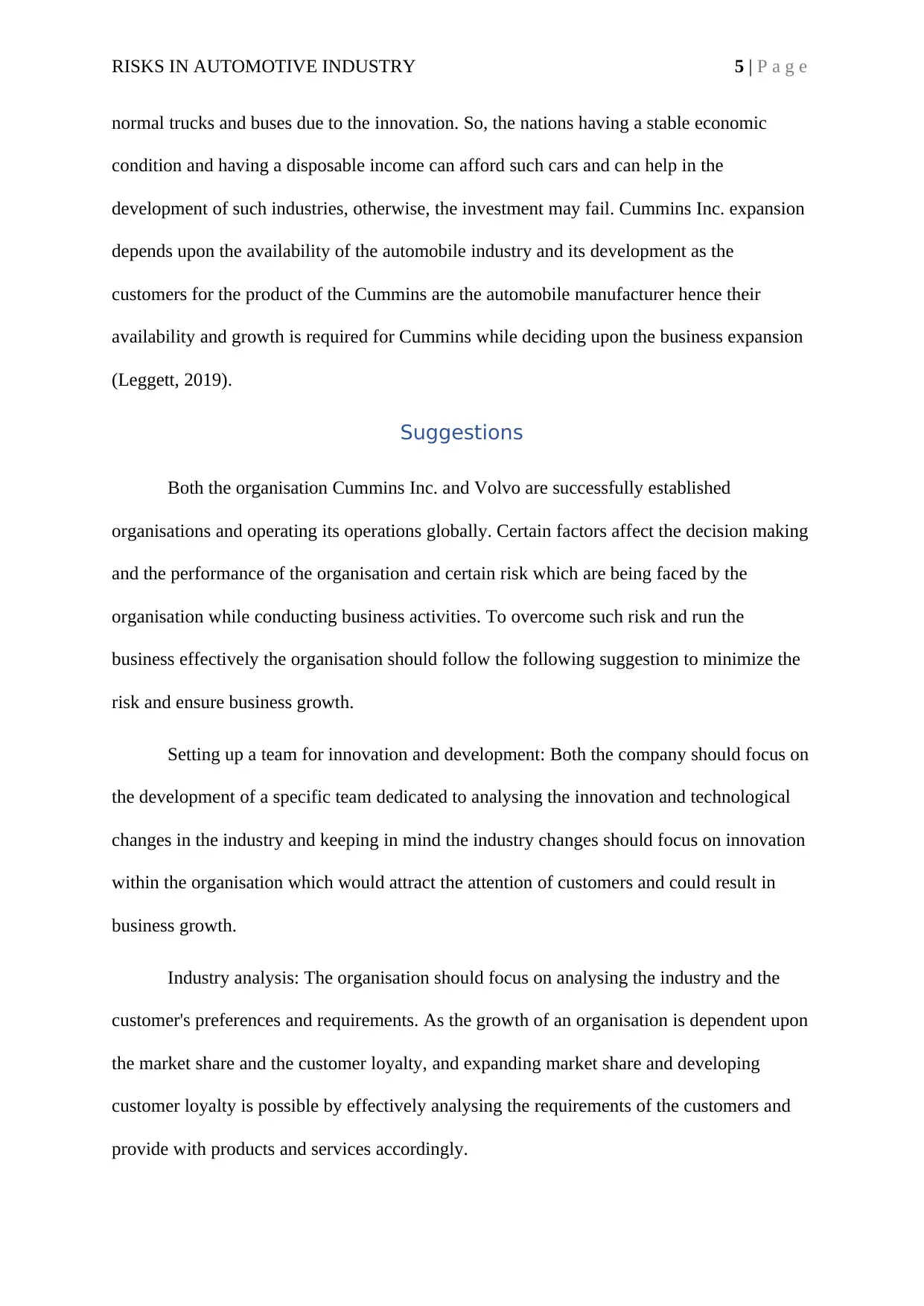
RISKS IN AUTOMOTIVE INDUSTRY 5 | P a g e
normal trucks and buses due to the innovation. So, the nations having a stable economic
condition and having a disposable income can afford such cars and can help in the
development of such industries, otherwise, the investment may fail. Cummins Inc. expansion
depends upon the availability of the automobile industry and its development as the
customers for the product of the Cummins are the automobile manufacturer hence their
availability and growth is required for Cummins while deciding upon the business expansion
(Leggett, 2019).
Suggestions
Both the organisation Cummins Inc. and Volvo are successfully established
organisations and operating its operations globally. Certain factors affect the decision making
and the performance of the organisation and certain risk which are being faced by the
organisation while conducting business activities. To overcome such risk and run the
business effectively the organisation should follow the following suggestion to minimize the
risk and ensure business growth.
Setting up a team for innovation and development: Both the company should focus on
the development of a specific team dedicated to analysing the innovation and technological
changes in the industry and keeping in mind the industry changes should focus on innovation
within the organisation which would attract the attention of customers and could result in
business growth.
Industry analysis: The organisation should focus on analysing the industry and the
customer's preferences and requirements. As the growth of an organisation is dependent upon
the market share and the customer loyalty, and expanding market share and developing
customer loyalty is possible by effectively analysing the requirements of the customers and
provide with products and services accordingly.
normal trucks and buses due to the innovation. So, the nations having a stable economic
condition and having a disposable income can afford such cars and can help in the
development of such industries, otherwise, the investment may fail. Cummins Inc. expansion
depends upon the availability of the automobile industry and its development as the
customers for the product of the Cummins are the automobile manufacturer hence their
availability and growth is required for Cummins while deciding upon the business expansion
(Leggett, 2019).
Suggestions
Both the organisation Cummins Inc. and Volvo are successfully established
organisations and operating its operations globally. Certain factors affect the decision making
and the performance of the organisation and certain risk which are being faced by the
organisation while conducting business activities. To overcome such risk and run the
business effectively the organisation should follow the following suggestion to minimize the
risk and ensure business growth.
Setting up a team for innovation and development: Both the company should focus on
the development of a specific team dedicated to analysing the innovation and technological
changes in the industry and keeping in mind the industry changes should focus on innovation
within the organisation which would attract the attention of customers and could result in
business growth.
Industry analysis: The organisation should focus on analysing the industry and the
customer's preferences and requirements. As the growth of an organisation is dependent upon
the market share and the customer loyalty, and expanding market share and developing
customer loyalty is possible by effectively analysing the requirements of the customers and
provide with products and services accordingly.
⊘ This is a preview!⊘
Do you want full access?
Subscribe today to unlock all pages.

Trusted by 1+ million students worldwide
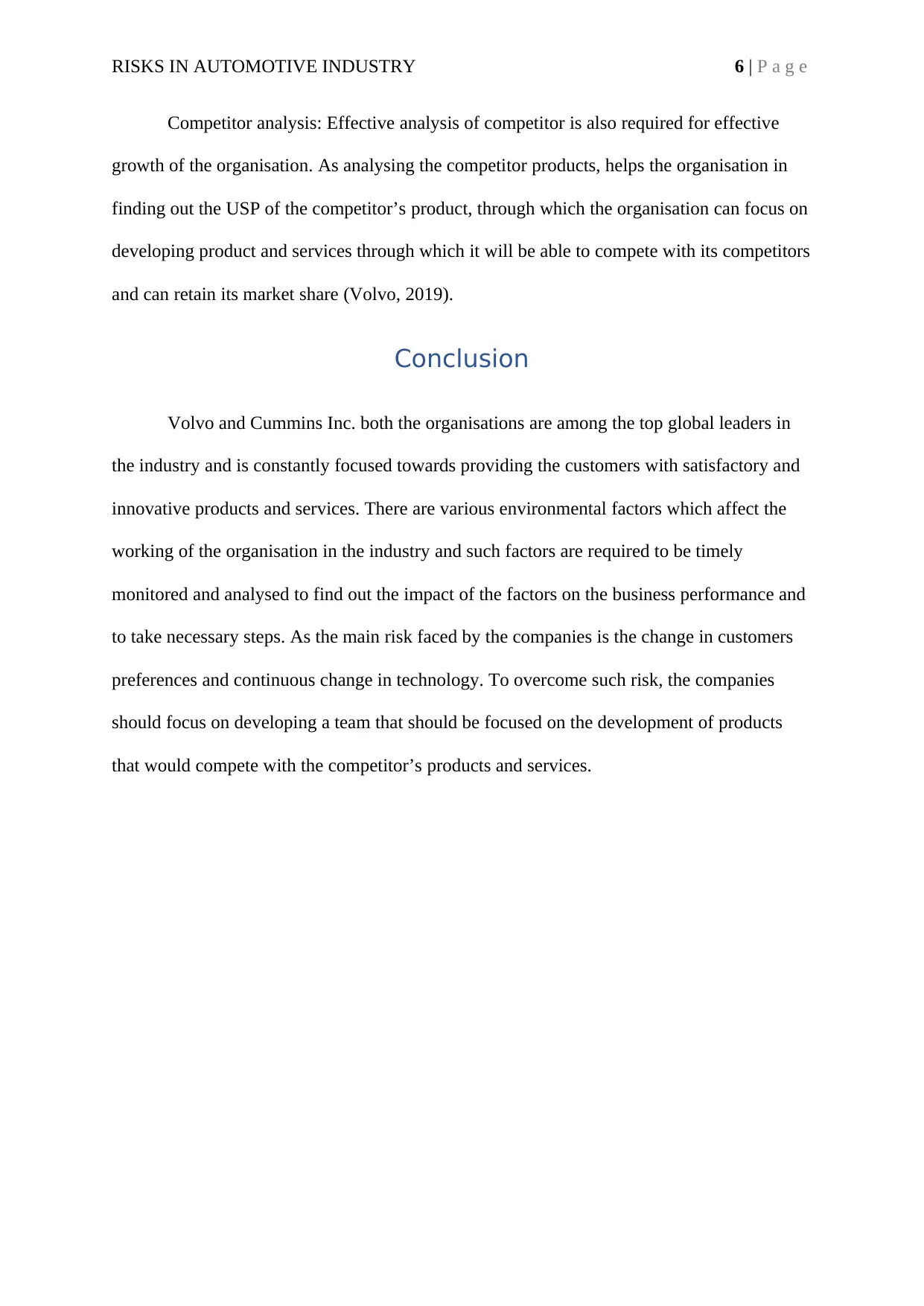
RISKS IN AUTOMOTIVE INDUSTRY 6 | P a g e
Competitor analysis: Effective analysis of competitor is also required for effective
growth of the organisation. As analysing the competitor products, helps the organisation in
finding out the USP of the competitor’s product, through which the organisation can focus on
developing product and services through which it will be able to compete with its competitors
and can retain its market share (Volvo, 2019).
Conclusion
Volvo and Cummins Inc. both the organisations are among the top global leaders in
the industry and is constantly focused towards providing the customers with satisfactory and
innovative products and services. There are various environmental factors which affect the
working of the organisation in the industry and such factors are required to be timely
monitored and analysed to find out the impact of the factors on the business performance and
to take necessary steps. As the main risk faced by the companies is the change in customers
preferences and continuous change in technology. To overcome such risk, the companies
should focus on developing a team that should be focused on the development of products
that would compete with the competitor’s products and services.
Competitor analysis: Effective analysis of competitor is also required for effective
growth of the organisation. As analysing the competitor products, helps the organisation in
finding out the USP of the competitor’s product, through which the organisation can focus on
developing product and services through which it will be able to compete with its competitors
and can retain its market share (Volvo, 2019).
Conclusion
Volvo and Cummins Inc. both the organisations are among the top global leaders in
the industry and is constantly focused towards providing the customers with satisfactory and
innovative products and services. There are various environmental factors which affect the
working of the organisation in the industry and such factors are required to be timely
monitored and analysed to find out the impact of the factors on the business performance and
to take necessary steps. As the main risk faced by the companies is the change in customers
preferences and continuous change in technology. To overcome such risk, the companies
should focus on developing a team that should be focused on the development of products
that would compete with the competitor’s products and services.
Paraphrase This Document
Need a fresh take? Get an instant paraphrase of this document with our AI Paraphraser

RISKS IN AUTOMOTIVE INDUSTRY 7 | P a g e
References
Cummins. (2019). Cummins Inc. Retrieved from Cummins:
https://www.cummins.com/company/overview
Guzik, K. (2013). Taking Hold of the Wheel: Automobility, Social Order, and the Law in
Mexico's Public Registry of Vehicles (REPUVE). Law & Society Review, 523-
554.
Jacobides, M. G., Macduffie, J. P., & Tae, C. J. (2015). Agency, Structure, And The
Dominance Of Oems: Change And Stability In The Automotive Sector. Strategic
Management Journal, 1942-1967. doi:https://doi.org/10.1002/smj.2426
Kangogo, J., & Gakure, R. (2013). Factors Affecting Electronic Procurement Implementation
in Automobile Industry of Kenya. International Journal of Management Sciences,
193-203.
Leggett, D. (2019). Diverging Markets, Expanding Risks. Retrieved from Just Auto:
https://www.just-auto.com/analysis/diverging-markets-expanding-risks_id86684.aspx
Mayyas, A., Qattawi, A., Omar, M., & Shan, D. (2012). Renewable and Sustainable Energy
Reviews. Renewable and Sustainable Energy Reviews, 1845-1862.
doi:10.1016/j.rser.2012.01.012
Nasdaq. (2019, December). VOLV B, VOLVO B, (SE0000115446). Retrieved from Nasdaq:
http://www.nasdaqomxnordic.com/aktier/microsite?
languageId=1&Instrument=SSE366
Rezvani, Z., Jansson, J., & Bodin, J. (2015). Advances in consumer electric vehicle adoption
research: A review and research agenda. Transportation Research Part D, 122-136.
doi:https://doi.org/10.1016/j.trd.2014.10.010
References
Cummins. (2019). Cummins Inc. Retrieved from Cummins:
https://www.cummins.com/company/overview
Guzik, K. (2013). Taking Hold of the Wheel: Automobility, Social Order, and the Law in
Mexico's Public Registry of Vehicles (REPUVE). Law & Society Review, 523-
554.
Jacobides, M. G., Macduffie, J. P., & Tae, C. J. (2015). Agency, Structure, And The
Dominance Of Oems: Change And Stability In The Automotive Sector. Strategic
Management Journal, 1942-1967. doi:https://doi.org/10.1002/smj.2426
Kangogo, J., & Gakure, R. (2013). Factors Affecting Electronic Procurement Implementation
in Automobile Industry of Kenya. International Journal of Management Sciences,
193-203.
Leggett, D. (2019). Diverging Markets, Expanding Risks. Retrieved from Just Auto:
https://www.just-auto.com/analysis/diverging-markets-expanding-risks_id86684.aspx
Mayyas, A., Qattawi, A., Omar, M., & Shan, D. (2012). Renewable and Sustainable Energy
Reviews. Renewable and Sustainable Energy Reviews, 1845-1862.
doi:10.1016/j.rser.2012.01.012
Nasdaq. (2019, December). VOLV B, VOLVO B, (SE0000115446). Retrieved from Nasdaq:
http://www.nasdaqomxnordic.com/aktier/microsite?
languageId=1&Instrument=SSE366
Rezvani, Z., Jansson, J., & Bodin, J. (2015). Advances in consumer electric vehicle adoption
research: A review and research agenda. Transportation Research Part D, 122-136.
doi:https://doi.org/10.1016/j.trd.2014.10.010

RISKS IN AUTOMOTIVE INDUSTRY 8 | P a g e
Rissola, G., Sorvik, J., Zingmark, A., & Ardenfors, M. (2019). Place-Based Innovation
Ecosystems. Joint Research Centre. doi:10.2760/95731
Sierzchula, W., Bakker, S., Maat, K., & Wee, B. V. (2014). The influence of financial
incentives and other socio-economic factors on electric vehicle adoption. Energy
Policy, 183-194. doi:https://doi.org/10.1016/j.enpol.2014.01.043
Volvo. (2019). Corporate Governance. Retrieved from Investors Volvo:
https://investors.volvocars.com/en/corporate-governance/company-structure/risks-
and-risk-management
Volvo. (2019). Our Mission, Vision & Aspirations. Retrieved from Volvo Group:
https://www.volvogroup.com/en-en/about-us/our-mission-and-vision.html
Rissola, G., Sorvik, J., Zingmark, A., & Ardenfors, M. (2019). Place-Based Innovation
Ecosystems. Joint Research Centre. doi:10.2760/95731
Sierzchula, W., Bakker, S., Maat, K., & Wee, B. V. (2014). The influence of financial
incentives and other socio-economic factors on electric vehicle adoption. Energy
Policy, 183-194. doi:https://doi.org/10.1016/j.enpol.2014.01.043
Volvo. (2019). Corporate Governance. Retrieved from Investors Volvo:
https://investors.volvocars.com/en/corporate-governance/company-structure/risks-
and-risk-management
Volvo. (2019). Our Mission, Vision & Aspirations. Retrieved from Volvo Group:
https://www.volvogroup.com/en-en/about-us/our-mission-and-vision.html
⊘ This is a preview!⊘
Do you want full access?
Subscribe today to unlock all pages.

Trusted by 1+ million students worldwide
1 out of 9
Related Documents
Your All-in-One AI-Powered Toolkit for Academic Success.
+13062052269
info@desklib.com
Available 24*7 on WhatsApp / Email
![[object Object]](/_next/static/media/star-bottom.7253800d.svg)
Unlock your academic potential
Copyright © 2020–2025 A2Z Services. All Rights Reserved. Developed and managed by ZUCOL.





